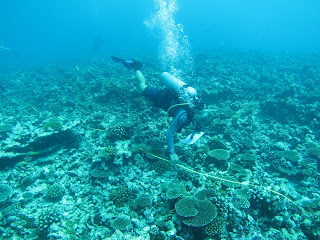MCSS developed a protocol for assessing the biodiversity and abundance of coral and fish in the waters surrounding the islands of North and Denis as a part of the MFF funded Coastal Development project in association with the Green Islands Foundation (GIF).
Since these initial surveys, every six months MCSS conducts coral and fish surveys in these areas as a part of the Green Islands Foundation (GIF) GEF funded Protected Areas Project. Last week I traveled to Denis Island with Georgia French (Project Coordinator) in order to conduct such surveys, as well as to pilot a new method for conducting turtle surveys in the Seychelles.
After a short flight from Mahé to Denis, we settled in to our accommodation on the staff estate and had a bite to eat before getting to work. The dive center was short on clients that afternoon, so they took us on a private cruise to the dive sites Batfish and Aquarium, where we started our surveys. Georgia surveyed fish while I surveyed coral, swimming a 50 meter belt transect and recording the percentage of substrate covered by hard and soft coral 2.5 meters to either side of the transect and every 5 meters along the transect.
 |
| Doing the marine transect surveys |
The coral cover was sparse, with no soft coral in sight, and the substrate was like the ruins of a long-lost civilization: a memory of the beauty and grandeur which once existed but can now only be found in the imagination. I could see the remains of the reef which at one time danced with color, but the area had been hit hard by the bleaching and tsunami events of the last fifteen years, and recovery is a slow process. Fortunately, it appeared that the reef is slowly recovering, with coral cover being dominated by numerous small patches of fast-growing corals. Continued monitoring will give more information, but hopefully the area will continue to improve, although it may never reach its former glory.
 |
| Meyer's butterfly fish (or Maypole butterfly fish) one of the colourful inhabitants of the Denis Island reef |
The next day, following an early breakfast, we headed to the seagrass beds which surround most of Denis to try a new method of conducting turtle surveys. This method involved me being tied, literally, to Georgia while we snorkeled through the seagrass beds and counted turtles, sharks, rays, and any other interesting encounters. We were supported by two friends from GIF who followed in a kayak, also counting the turtles they saw. Georgia’s and my position in the water allowed us to record the size, species, and, if possible, sex of the turtles we encountered, while our friends’ positions in the kayak provided a verification of our count.
 |
| Snorkelling surveys for turtles in the shallow waters |
After a morning filled with snorkeling for turtles, during which we also saw numerous thornyback rays, a juvenile lemon shark, juvenile Picasso Triggerfish (so cute when they’re tiny!), and many other fish, we returned to the dive center for one more coral/fish survey. This one we did as a shore dive, swimming out to the house reef, which was an intricate, though shallow, underwater environment. Unfortunately, the coral cover here was even less substantial and diverse than at the other sites.
That afternoon Georgia and I went looking for Seychelles Paradise Flycatchers, an endemic bird found only on La Digue and Denis islands. Georgia had done work with flycatchers on Denis previously, so she knew their general territories and how to find them, and was able to show me a nesting female and its mate, which was a fun experience.
The next morning we conducted one more turtle survey, seeing numerous green turtles. On the walk along the beach back to the dive center I saw my first turtle tracks, a green turtle’s, though, even after scaling a steep erosion cliff and digging in two places, she failed to lay any eggs. Our work finished, and a day ahead of schedule, we grabbed a quick bite to eat before boarding our flight back to Mahé.



